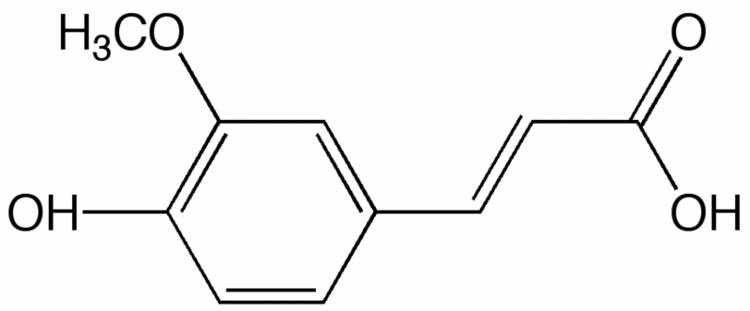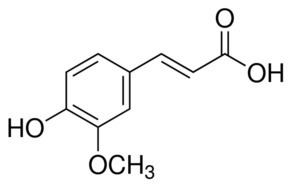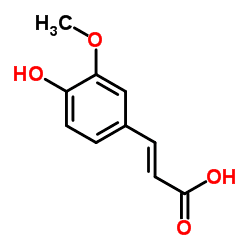Formula C10H10O4 | Molar mass 194.18 g/mol Appearance Crystalline Powder | |
 | ||
Ferulic acid market industry research report and forecast to 2021
Ferulic acid is a hydroxycinnamic acid, a type of organic compound. It is an abundant phenolic phytochemical found in plant cell wall components such as arabinoxylans as covalent side chains. It is related to trans-cinnamic acid. As a component of lignin, ferulic acid is a precursor in the manufacture of other aromatic compounds. The etymology is from the genus Ferula, referring to the giant fennel (Ferula communis).
Contents
- Ferulic acid market industry research report and forecast to 2021
- Occurrence in nature
- In food
- In herbal medicines
- In processed foods
- Biosynthesis
- Biodegradation
- Ecology
- Extraction
- Bio medical considerations
- As a precursor to vanillin
- Mass spectrometry
- Bitterness masker
- References
Occurrence in nature

As a building block of lignocelluloses, such as pectin and lignin, ferulic acid is ubiquitous in the plant kingdom.
In food

Ferulic acid is found in the seeds of coffee, apple, artichoke, peanut, and orange, as well as in both seeds and cell walls of commelinid plants (such as rice, wheat, oats, the Chinese water chestnut (Eleocharis dulcis) and pineapple). Often in the form of chlorogenic acid.

In cereals, ferulic acid is localized in the bran the hard outer layer of grain. In wheat, phenolic compounds are mainly found in the form of insoluble bound ferulic acid and be relevant to resistance to wheat fungal diseases. The highest known concentration of ferulic acid glucoside has been found in flax seed (4.1 ± 0.2 g/kg). It is also found in barley grain.

Asterid Eudicot plants can also produce ferulic acid. The tea brewed from the leaves of yacón (Smallanthus sonchifolius), a plant traditionally grown in the Northern and Central Andes, contains quantities of ferulic acid. In legumes, the white bean variety navy bean is the richest source of ferulic acid among the common bean (Phaseolus vulgaris) varieties. It is also found in horse grams (Macrotyloma uniflorum).

Although there are many sources of ferulic acid in nature, its bioavailability is limited based on the form in which it is present, with free ferulic acid having a poor water solubility hence poor bioavailability. In wheat grain, ferulic acid is found bound to cell wall polysaccharides, which has an effect on its release and absorption in the small intestine.
In herbal medicines

Ferulic acid has been identified in Chinese medicine herbs such as Angelica sinensis (female ginseng), Cimicifuga heracleifolia and Lignsticum chuangxiong. It is also found in the tea brewed from the European centaury (Centaurium erythraea), a plant used as a medical herb in many parts of Europe,
In processed foods

Cooked sweet corn releases increased levels of ferulic acid. As plant sterol esters, this compound is naturally found in rice bran oil, a popular cooking oil in several Asian countries.
Ferulic acid glucoside can be found in commercial breads containing flaxseed. Rye bread contains ferulic acid dehydrodimers.
Biosynthesis
Biosynthesis of ferulic acid is by the action of the enzyme caffeate O-methyltransferase. It is biosynthesized from caffeic acid.
Ferulic acid, together with dihydroferulic acid, is a component of lignocellulose, serving to crosslink the lignin and polysaccharides, thereby conferring rigidity to the cell walls.
It is an intermediate in the synthesis of monolignols, i.e., the monomers of lignin, and is also used for the synthesis of lignans.
Biodegradation
Ferulic acid is converted by certain strains of yeast, notably strains used in brewing of wheat beers, such as Saccharomyces delbrueckii (Torulaspora delbrueckii), to 4-vinyl guaiacol (2-methoxy-4-vinylphenol) which gives beers such as Weissbier and Wit their distinctive "clove" flavour. Saccharomyces cerevisiae (dry baker's yeast) and Pseudomonas fluorescens are also able to convert trans-ferulic acid into 2-methoxy-4-vinylphenol. In P. fluorescens, a ferulic acid decarboxylase has been isolated.
Ecology
Ferulic acid is one of the possible plant compounds that initiate Agrobacterium tumefaciens to infect plant cells.
Extraction
It can be extracted from wheat bran and maize bran using concentrated alkali.
Bio-medical considerations
Ferulic acid, like many natural phenols, is an antioxidant in vitro in the sense that it is reactive toward free radicals such as reactive oxygen species (ROS). ROS and free radicals are implicated in DNA damage, cancer, and accelerated cell aging. Animal studies and in vitro studies suggest that ferulic acid may have direct antitumor activity against breast cancer and liver cancer. Ferulic acid may have pro-apoptotic effects in cancer cells, thereby leading to their destruction. Ferulic acid may be effective at preventing cancer induced by exposure to the carcinogenic compounds benzopyrene and 4-nitroquinoline 1-oxide. Note that these are not randomized controlled trials done with human participants, and therefore, the results of these studies may not be directly applicable to human use.
If added to a topical preparation of ascorbic acid and vitamin E, ferulic acid may reduce oxidative stress and formation of thymine dimers in skin. There is also a small amount of research showing oral supplements of ferulic acid can inhibit melanin production in the process of skin whitening.
As a precursor to vanillin
Ferulic acid, being highly abundant, may be useful as a precursor in the manufacturing of vanillin, a synthetic flavoring agent often used in place of natural vanilla extract. However, biotechnological processes may be the most efficient method to use ferulic acid as a precursor, and as such, research is still ongoing.
Mass spectrometry
It is used as a matrix for proteins in MALDI mass spectrometry analyses.
Bitterness masker
Kraft Foods has patented the use of sodium ferulate to mask the bitter aftertaste of the artificial sweetener acesulfame potassium.
